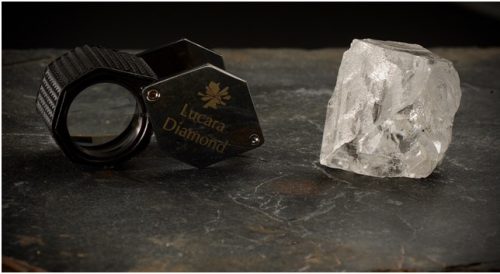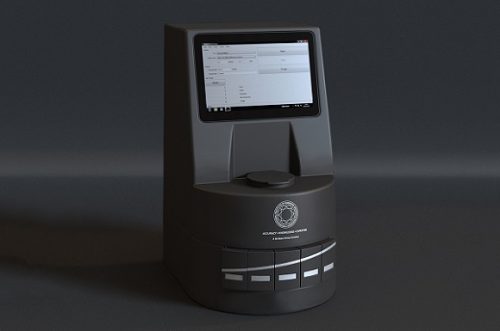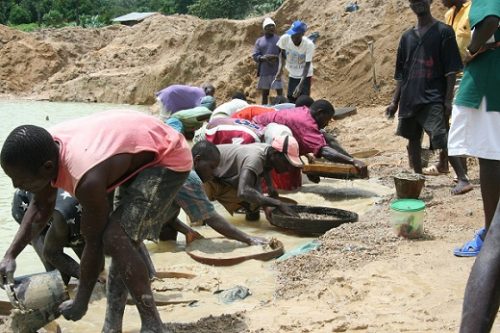
Thursday, 26 April 2018
Lucara Diamond Corp. Finds 327-Carat Top White Gem At Karowe Mine

Lucara Diamond Corp. Finds 327-Carat Top White Gem At Karowe Mine

Lucara Diamond Corporation has recovered a 327 carat top colour gem diamond from its one hundred percent owned Karowe diamond mine in Botswana.
Wednesday, 25 April 2018
Labs Refute Claims HPHT Escaping Detection

Major gemological laboratories have rebuffed claims that detection machines are failing to spot synthetic diamonds that have undergone irradiation.
In a trade alert last week, Diamond Services argued that the treatment, generally used to alter the color of a stone, can mask the phosphorescence effect when diamonds created using High Pressure-High Temperature (HPHT) undergo scanning at room temperature.
While detection machines can often identify HPHT diamonds because they phosphoresce — or glow — under ultra-violet light, certain devices fail to spot some of those stones that have been subject to irradiation, the Hong Kong-based diamond-technology company argued.
However, De Beers and the Gemological Institute of America (GIA) have denied the impact of such a phenomenon on their machines’ ability to sift out HPHT synthetics.
“The International Institute of Diamond Grading and Research (IIDGR) confirms that its instruments AMS2, SYNTHdetect, DiamondView and DiamondSure are all effective at screening HPHT synthetic material which has been irradiated and is tested at room temperature,” the De Beers-owned grading unit said in a statement last week.
“Any business using these devices can have full confidence that any such material will be detected without the need to undertake tests at different temperatures,” it added.
Meanwhile, although detection devices based on phosphorescence may not be able to detect some HPHT-grown irradiated synthetics, the GIA’s machines can spot them, the Carlsbad, California-headquartered laboratory stressed.
“The ability of the instruments that GIA uses to differentiate natural diamonds from HPHT and CVD [chemical vapor deposition]-grown synthetic diamonds, including the GIA iD100 gem-testing device and the GIA Melee Analysis Service, is not affected by irradiation treatment,” the GIA told Rapaport News.
Examining diamonds at the temperature of liquid nitrogen can be an extremely accurate method of detecting synthetics, while a technique called Raman spectroscopy is a simple way of spotting irradiated diamonds, according to Joseph Kuzi, founder and president of Diamond Services.
“Our latest findings indicate that the diamond and jewelry trades should show extra caution, but we do not claim that irradiated HPHT-grown synthetic diamonds are undetectable,” Kuzi said.
Labs Refute Claims HPHT Escaping Detection

Major gemological laboratories have rebuffed claims that detection machines are failing to spot synthetic diamonds that have undergone irradiation.
In a trade alert last week, Diamond Services argued that the treatment, generally used to alter the color of a stone, can mask the phosphorescence effect when diamonds created using High Pressure-High Temperature (HPHT) undergo scanning at room temperature.
While detection machines can often identify HPHT diamonds because they phosphoresce — or glow — under ultra-violet light, certain devices fail to spot some of those stones that have been subject to irradiation, the Hong Kong-based diamond-technology company argued.
However, De Beers and the Gemological Institute of America (GIA) have denied the impact of such a phenomenon on their machines’ ability to sift out HPHT synthetics.
“The International Institute of Diamond Grading and Research (IIDGR) confirms that its instruments AMS2, SYNTHdetect, DiamondView and DiamondSure are all effective at screening HPHT synthetic material which has been irradiated and is tested at room temperature,” the De Beers-owned grading unit said in a statement last week.
“Any business using these devices can have full confidence that any such material will be detected without the need to undertake tests at different temperatures,” it added.
Meanwhile, although detection devices based on phosphorescence may not be able to detect some HPHT-grown irradiated synthetics, the GIA’s machines can spot them, the Carlsbad, California-headquartered laboratory stressed.
“The ability of the instruments that GIA uses to differentiate natural diamonds from HPHT and CVD [chemical vapor deposition]-grown synthetic diamonds, including the GIA iD100 gem-testing device and the GIA Melee Analysis Service, is not affected by irradiation treatment,” the GIA told Rapaport News.
Examining diamonds at the temperature of liquid nitrogen can be an extremely accurate method of detecting synthetics, while a technique called Raman spectroscopy is a simple way of spotting irradiated diamonds, according to Joseph Kuzi, founder and president of Diamond Services.
“Our latest findings indicate that the diamond and jewelry trades should show extra caution, but we do not claim that irradiated HPHT-grown synthetic diamonds are undetectable,” Kuzi said.
Monday, 23 April 2018
Petra Diamonds record output

The South African diamond producer, owner of the iconic Cullinan mine, which produced the diamonds for the British crown jewels, said revenue for the quarter ended March 31 climbed 44% to $172 million, from $119 million a year earlier.
Petra Diamonds saw third-quarter revenue grow by 44% after it produced and sold more gems.
The company, known for some major recent findings, attributed part of the revenue growth to the fact it sold 1,373,771 carats of diamonds compared to 1,069,886 sold in the same period a year earlier.
While production jumped 20% to a record quarterly volume of 1,194,947 carats, Petra said illegal mining at its Kimberley Ekapa Mining JV dented output during the quarter by restricted access to high grade dumps at the surface re-treatment operation.
It also said its full year 2018 revenue continued to be impacted by the inability to sell a blocked diamond parcel from it Williamson mine of about 71,000 carats. The shipment was seized by the Tanzanian government in September last year, as part of the country’s ongoing probe into alleged wrongdoing in the diamond and tanzanite sectors.
Chief executive Johan Dippenaar said the company’s focus would move away from volume targets to value optimization.
‘While we are very encouraged by the operational delivery against our long-term expansion plans, risks to performance continue to relate to increased volatility in the ZAR/US$ exchange rate, grade and pricing variability at Cullinan,” Dippenaar said in the statement, adding that the outlook for its Williamson mine as well as the blocked diamond parcel were also weighing on the company’s future.
Source:DCLA
Petra Diamonds record output

The South African diamond producer, owner of the iconic Cullinan mine, which produced the diamonds for the British crown jewels, said revenue for the quarter ended March 31 climbed 44% to $172 million, from $119 million a year earlier.
Petra Diamonds saw third-quarter revenue grow by 44% after it produced and sold more gems.
The company, known for some major recent findings, attributed part of the revenue growth to the fact it sold 1,373,771 carats of diamonds compared to 1,069,886 sold in the same period a year earlier.
While production jumped 20% to a record quarterly volume of 1,194,947 carats, Petra said illegal mining at its Kimberley Ekapa Mining JV dented output during the quarter by restricted access to high grade dumps at the surface re-treatment operation.
It also said its full year 2018 revenue continued to be impacted by the inability to sell a blocked diamond parcel from it Williamson mine of about 71,000 carats. The shipment was seized by the Tanzanian government in September last year, as part of the country’s ongoing probe into alleged wrongdoing in the diamond and tanzanite sectors.
Chief executive Johan Dippenaar said the company’s focus would move away from volume targets to value optimization.
‘While we are very encouraged by the operational delivery against our long-term expansion plans, risks to performance continue to relate to increased volatility in the ZAR/US$ exchange rate, grade and pricing variability at Cullinan,” Dippenaar said in the statement, adding that the outlook for its Williamson mine as well as the blocked diamond parcel were also weighing on the company’s future.
Source:DCLA
Sunday, 22 April 2018
De Beers to Sell Diamonds from Artisanal Miners

The company has partnered with the Diamond Development Initiative (DDI) on the project, known as GemFair, which is set to launch a pre-pilot phase this month. GemFair will provide tracking technology to artisanal and small-scale miners (ASM), aiming to create a secure and transparent route to market for their diamonds, De Beers said in a statement last week.
“The ASM sector represents a critical income source for many poverty-affected communities,” said De Beers CEO Bruce Cleaver. “However, due to parts of the sector being largely informal and unregulated, it lacks access to established international markets and the ability to derive fair value for participants.”
De Beers hopes the new project will help grow acceptance and prospects for artisanal miners, in addition to creating a new supply source for the company, Cleaver added.
Miners who want to participate in the program need to receive certification from the DDI as well as from GemFair. Participants will then be given a diamond “toolkit,” which includes technology enabling them to digitally track all stones throughout the supply chain.
Once the initiative is operational, GemFair will begin buying stones from participating miners, which will then be sold via De Beers’ Auction Sales channel.
De Beers has not set a date for the pilot’s completion, but hopes to make the first purchase later this year.
Source: Diamonds.net
Subscribe to:
Comments (Atom)
Paraiba Tiffany Necklace Sets New World Record at Christie’s New York
A spectacular Tiffany & Co. necklace has made auction history, achieving a record-setting USD $4.2 million and establishing a new worl...

-
A yellow diamond ring was the star of the most recent jewelry sale at Phillips in Hong Kong, fetching HKD 8.9 million ($1.1 million). The ro...
-
Russia’s diamond miner Alrosa said on Tuesday that its sales of rough and polished diamonds totaled $559.5 million in March. There ...
-
A collaboration by Pandora, the world’s biggest jewelry brand, and the e-commerce platform Amazon, has smashed a sophisticated counterfeit...
